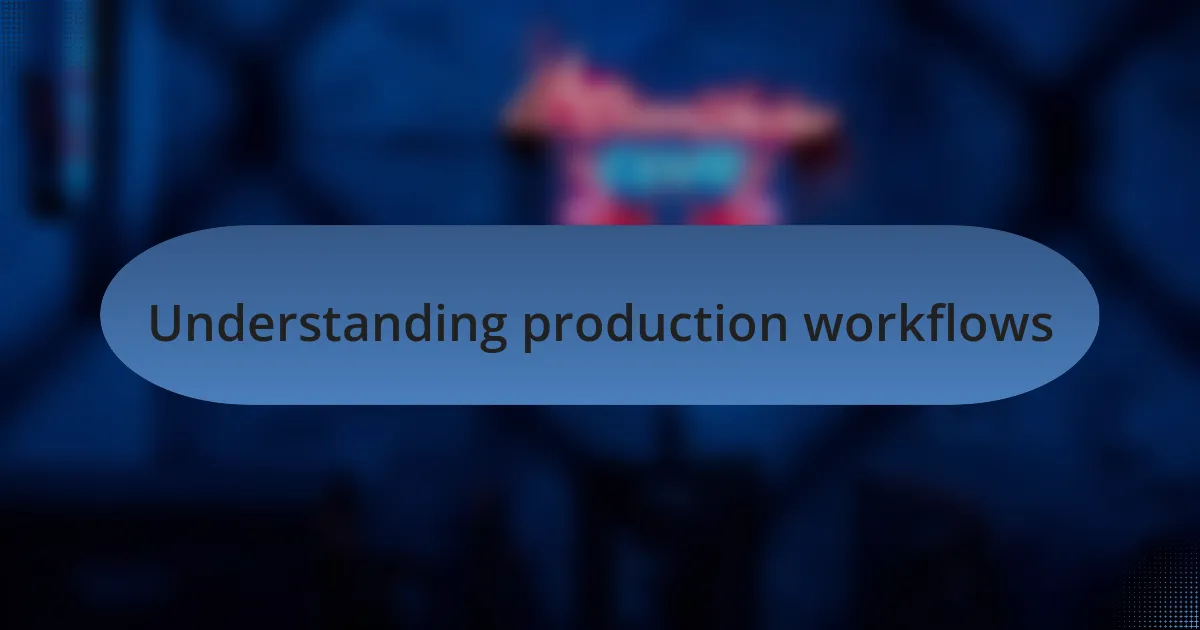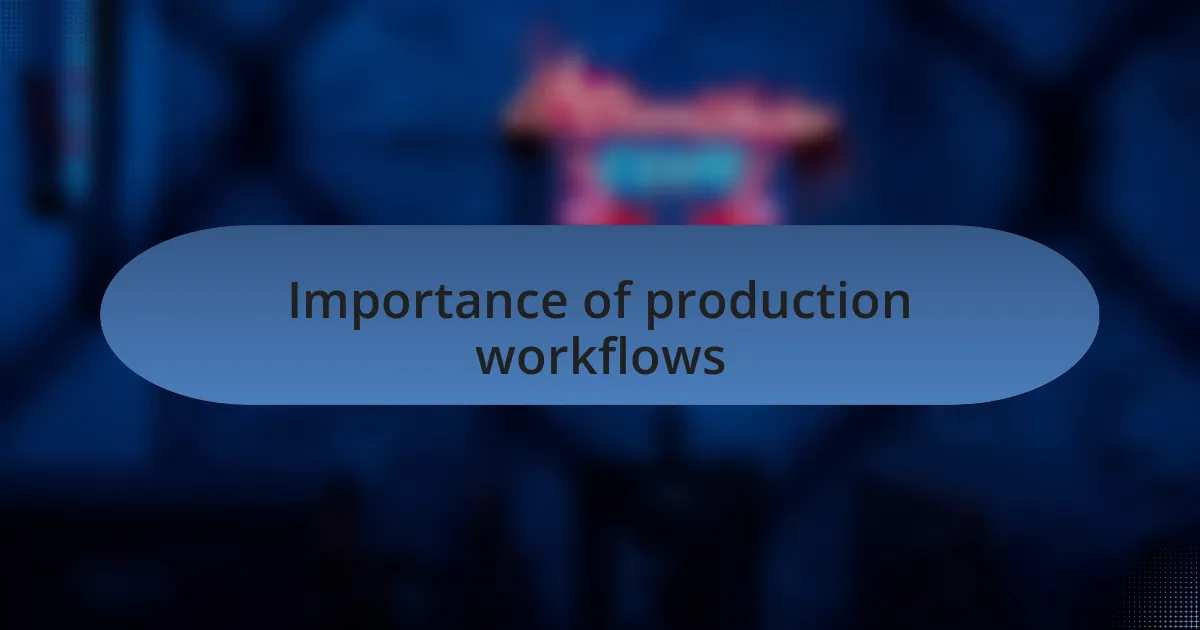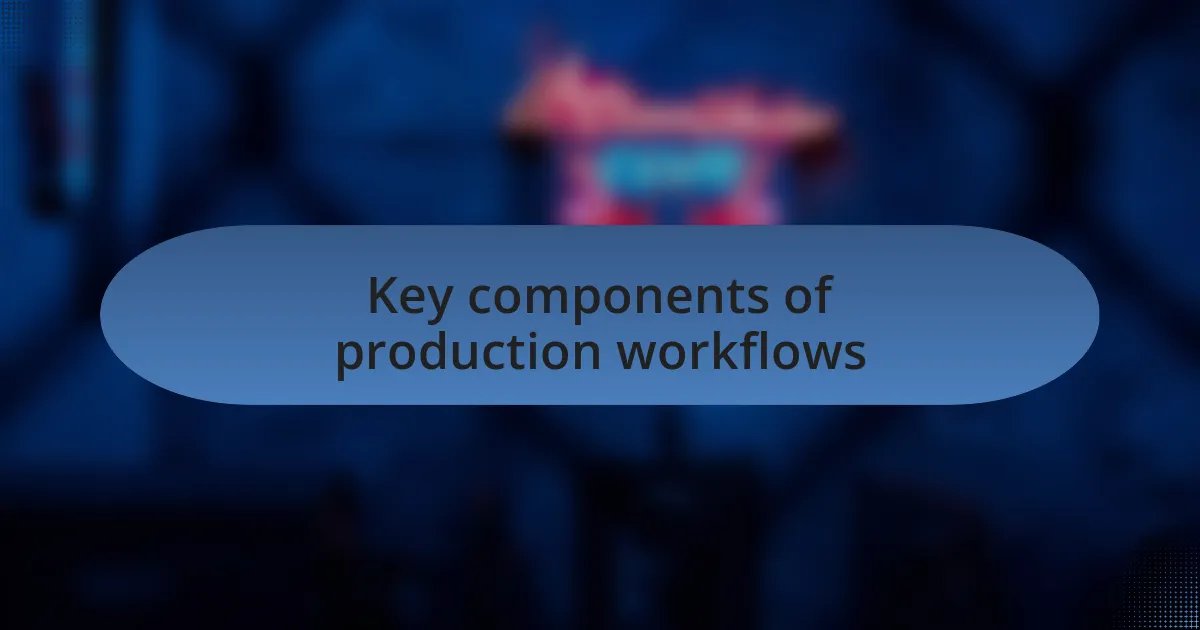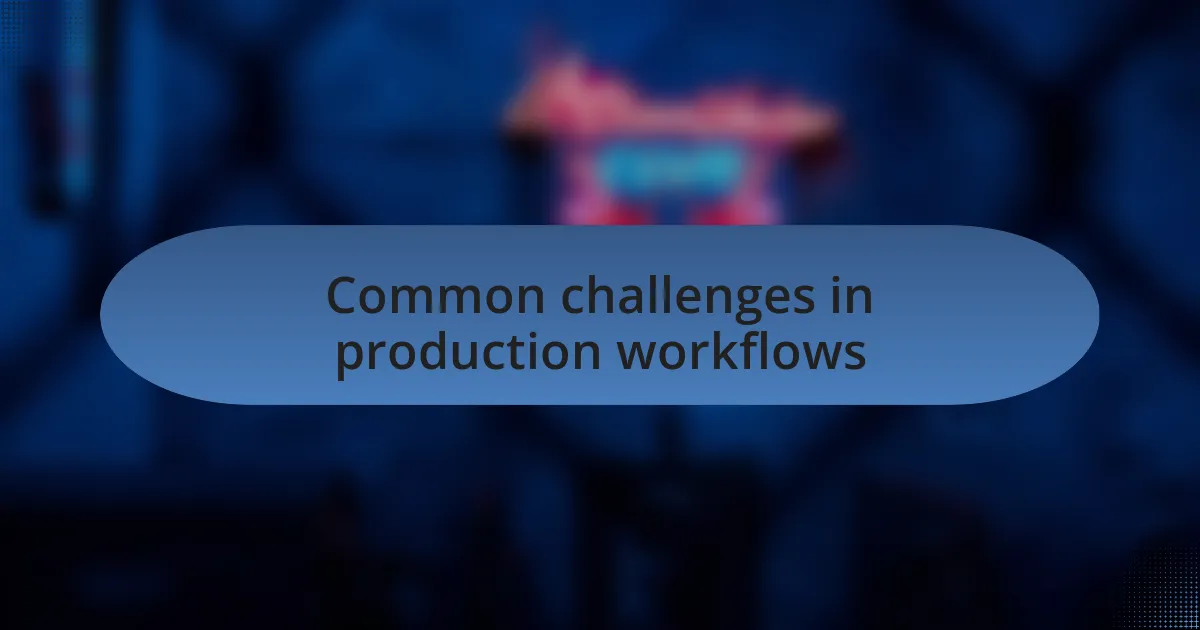Key takeaways:
- Mapping out production phases enhances coordination and communication among artists, producers, and engineers, reducing chaotic moments.
- Implementing a solid feedback loop elevates the artistic process and strengthens team dynamics through open communication.
- Utilizing technology and project management tools improves workflow efficiency and keeps team members aligned on duties and deadlines.
- Regularly reviewing completed projects provides insights that can inform and optimize future production processes.

Understanding production workflows
Understanding production workflows is crucial for anyone in the music industry. From my experience, I’ve seen how a well-structured workflow can make or break a project. Have you ever felt overwhelmed by all the moving parts? A clear process can ease that confusion, guiding you through each step—from pre-production planning to post-release marketing.
When I was working on an album, I learned the importance of mapping out each phase of production. It wasn’t just about recording; it involved careful coordination among artists, producers, and sound engineers. Each person’s role ties into the overall workflow, and missing even a small detail can lead to chaos. I still remember the late nights spent adjusting schedules; it showed me how vital communication is in maintaining a smooth workflow.
One thing that often gets overlooked is the feedback loop within production workflows. There’s this exhilarating moment when a rough cut gets shared, and the team offers reactions. It’s thrilling yet nerve-wracking—how do you balance artistic vision with constructive criticism? I’ve found that fostering an open environment for feedback not only elevates the project but also strengthens team dynamics.

Importance of production workflows
Production workflows are essential because they enhance efficiency and creativity in music projects. I remember a time when I was juggling multiple artists during a recording session. Without a solid workflow in place, the chaos could have easily derailed us. Instead, by having a clear plan, we stayed organized and focused, allowing everyone to bring their best to the table.
Another critical aspect of production workflows is accountability. During a particularly complex project, we assigned specific roles to each team member. When deadlines approached, it was crystal clear who was responsible for what. This structure not only reduced stress but also increased our productivity. Have you ever sensed how much smoother things run when everyone knows their duties?
The emotional impact of having a solid workflow shouldn’t be underestimated either. I recall the palpable relief when we successfully hit all milestones for an album release. That sense of accomplishment not only boosts morale but fosters a sense of ownership among the team. It’s about more than just the music; it’s about creating an experience where everyone feels invested in the outcome.

Key components of production workflows
One key component of production workflows is the pre-production stage, where planning takes center stage. I once had a project where we spent weeks mapping out every detail before hitting the studio. This meticulous groundwork led to astonishing results; the recording sessions felt more like a creative celebration than a stressful deadline. Isn’t it amazing how a little extra planning can turn chaos into harmony?
Another essential element is the communication framework within the team. I’ve found that open channels for feedback can transform a production. During one project, we implemented daily check-ins, allowing everyone to share their insights or concerns. This approach not only improved our collaboration but also helped in addressing minor issues before they snowballed into major setbacks. Have you ever noticed how a simple conversation can shift the direction of a project?
Finally, the post-production phase is where everything comes together and magic happens. There was a time when we worked late into the night to perfect an album’s final mixes. The sense of pride I felt as we listened to the completed tracks was overwhelming. Wouldn’t you agree that the journey through editing and mastering is both exhausting and exhilarating? Each component of the workflow feeds into this final crescendo, highlighting the importance of every stage in the production process.

Best practices for record labels
One best practice for record labels is fostering a strong artist-label relationship. I recall a time when we decided to spend a weekend retreat with only a few artists and our staff. This experience was not only enlightening, but it also built trust and opened up channels for creativity that we hadn’t tapped into before. How often do labels prioritize these meaningful connections?
In my experience, investing in marketing and promotion should never be an afterthought. When we launched an album, we dedicated sufficient time to crafting a narrative around it. This story became a vital part of our promotional activities and resonated deeply with fans. Have you ever felt a stronger connection to art because of the story behind it? It’s incredible how a well-told story can elevate the music itself.
Lastly, record labels should embrace data analytics to make informed decisions. I remember a project where analyzing streaming and social media engagement changed our approach completely. By understanding which tracks resonated best with the audience, we could tailor our marketing strategies for maximum impact. How are you leveraging data in your production workflows? Taking a data-driven approach not only sharpens your goals but also guides you on this music journey with clarity and purpose.

Common challenges in production workflows
Many production workflows face challenges that can disrupt the creative process. I remember a time when a critical technical glitch caused us to miss a deadline right before a major album drop. It was a reminder of how essential it is to have reliable technology and backup plans in place. Do you have strategies for troubleshooting and ensuring that your production timeline stays on track?
Another common hurdle is communication breakdown, particularly when multiple artists and collaborators are involved. I once found ourselves in a situation where misaligned expectations led to a misunderstanding about the vision for a track. It was frustrating to realize that clear communication could have prevented the chaos. How often do you check in with your team and artists to ensure everyone is on the same page?
Balancing creative freedom with the structured nature of production can also pose a significant challenge. I’ve witnessed artists struggle with constraints while trying to infuse their unique style into the project. There’s something special about having that creative spark, yet it needs to fit within a timeline. How do you strike that balance without stifling artistic expression?

My personal workflow experience
My personal workflow is an evolving journey, shaped by countless sessions in the studio and the unique personalities of the artists I collaborate with. I recall a particularly enlightening moment when I began incorporating visual components, like storyboards, to map out projects. It transformed our discussions and made the creative intentions clearer. Have you ever tried visually representing your ideas? It might just illuminate pathways you hadn’t considered before.
There was a time when I made it a point to document our process meticulously, which really paid off. I discovered that keeping an ongoing log of decisions and shifts helped maintain continuity, especially when artists took breaks or needed to step back. I also learned that it allowed us to revisit ideas that might have seemed less relevant at the time but later sparked innovative solutions. Have you ever found old notes or tracks that reignited your inspiration?
On another note, refining my workflow also meant assessing my environment. I remember rearranging the studio space one day, hoping to create a more inviting atmosphere. That simple change made our brainstorming sessions feel electric, allowing creativity to flow freely. It’s interesting how physical space can influence our mental space. Have you thought about how your surroundings shape your creative process?

Tips for optimizing production workflows
When it comes to optimizing production workflows, I’ve found that leveraging technology can make a significant difference. For instance, using project management software allowed me to streamline communication and keep everyone on the same page. Have you ever tried using digital tools to track your progress? It can be a game-changer, ensuring that nothing falls through the cracks while enhancing collaboration.
Another effective strategy I’ve employed is setting clear deadlines, which adds a sense of urgency to the process. I remember working on an EP where we established a timeline for each phase, from songwriting to final mixing. This not only kept the momentum going but also sparked a friendly competition among our team members. Would you believe how a structured timeline can elevate productivity? The clarity it brings often leads to unexpected bursts of creativity.
Lastly, regularly reviewing your completed projects can provide invaluable insights. After finishing an album, I took the time to dissect what worked and what didn’t, which deepened my understanding of our workflow. This reflective practice felt both empowering and illuminating. Have you ever taken the time to evaluate your past projects? You might discover patterns that could enhance your future work!